
|
Besides and parallel to the uninscribed local copper coins of
post-Mauryan eastern Malwa we
have various series of inscribed coins in that region. The civic
issues of Kurara, Vidisha and Nandinagara are die-struck, whereas the
civic coins of Bhagila have been punchmarked. As for the coins with
personal names on them all are punchmarked except some issues of Vasumitra.
In analogy to
their uninscribed companions, these issues originate from
several urban centers in eastern Malwa. Among them only the civic
issues such as those from Kurara, Vidisha, Nandinagara and
Bhagila unmistakebly bear the name of the issuing city. Kurapurika
civic coins have also been reported from eastern Malwa but the exact
location of Kurapurika remains uncertain and trade activities might
have brought these coins to the Eran-Vidisha region. P.P. Kulkarni has
published
a very useful survey of the civic issues from the Narmada valley in
ICS-NL 37, pp.3-21 ('New discoveries in coins from Narmada valley
: geographical and historical implications'). He reports a large number
of coins of Kurara, Bhagila,
Mahismati and at least one Kurapurika coin to have been found at
Nadner, i.e. ancient Nandinagara. Other Kurapurika coins however came
from the Mahismati region on the banks of the Narmada and that is where
Kulkarni sees the origin of the Kurapurika series, the ancient site of
Purika near Omkareshwar.
As for the
issues with personal names on them it is difficult to define the exact
places of origin which have to be looked for among the most important
urban centers
of the region such as Eran, Vidisha and Nandinagara (Nadner). Eran was
located near the junction of Bina and Betwa river and Vidisha,
east of the Betwa river, near modern Bhopal, a short distance from
ancient Besnagar. Both cities dominated the Betwa valley and important
trade routes went through them. Given the
lack of certainty with reference to the precise attribution of most
coin types the term Eran-Vidisha coin series can be used to signify
the whole series.
Typologically otherwise similar to the uninscribed
punchmarked coins, the inscribed ones have an extra Brahmi legend punch
designating a personal name mostly at the top of the
coin. Considering the use of the prefix rajno these personal names can
be taken as the names of independent rulers. Among them
mitra-ending names are most common: Bhanumitra, Narayanamitra,
Vasumitra, Vajimitra and
Vishnumitra. In addition we have coins of
Damabhadra, Sujetha, Ravibhuti, Vasusharma, Hathideva and Bhumidata
(some of these names had been read incorrectly in the past and
different researchers have meanwhile proposed the here used new readings).
A
lot of guesswork
has been done on the possible identity of some of these rulers with
some of the Sunga/ Kanva rulers from the Purana lists. Regrettably we
have only identities or similarities of certain names. S.J.Manglam and
Pushpa Tiwari presented a rich collection in the 'Shankar Tiwari
collection of early coins from Narmada valley' in 2001. They pointed to
the
fact that 'the diversity of symbols do not satisfactorily explain how
they could be a homogeneous series issued by a dynasty'. Suggesting the
existence of two different rulers Vasumitra (based on the existence of
punchmarked and die-struck issues inscribed in this name) the authors
pondered the
idea that the earlier Vasumitra might have been the fourth Sunga king
from the Puranas and also pointed to the fact that Narayanamitra's name
recalls that of the third Kanva king from the Purana list.
Concerning the Ravibhuti-Hathideva-Bhumidata group S.J. Manglam
followed an earlier idea of Alka Tiwari and speculated whether they
were Sunga/ Kanva kings pointing to the similarity of names from the
Purana lists: Devabhuti, the last Sunga, dethroned by his minister
Vasudeva Kanva who in turn was succeeded by Bhumimitra. Manglam
emphasized the fact that several Ravibhuti coins were overstruck by
Hathideva thus supporting the inscriptional evidence on the relative
chronology under the assumption that Devabhuti of the Puranas changed
to Ravibhuti of the coins, Vasudeva to Hathideva and Bhumimitra to
Bhumidata.
Shailendra Bhandare ('Numismatics and history: the Maurya-Gupta interlude in the
Gangetic plain' in 'Between the Empires' 2006, edited by Patrick Olivelle) added the interesting
aspect that the name
Susharman, according to the Puranas the last Kanva king who was overthrown
by Simuka Satavahana, appears as Vasusharman on the coins. But doubting
the reliability of a 'Sunga-Kanva' succession as told in the Puaranas,
he denies any identity of the coin issuers with Sunga-Kanva rulers. On
typological grounds, particularly the common use of the lotus
symbol, Bhandare links Ravibhuti with the city issues of Bhagila
near Vidisha, where he sees the Ravibhuti-Hathideva
succession to have happened as nothing more than just a local event. In
a similar typological approach he uses another peculiar symbol from the region, the
'taurine fixed in an open railing' to group together Hathideva,
Bhumidata, Narayanamitra and Vasuvarma.
Coming to the coins of the -bhadra rulers we have an important piece of
evidence, the Besnagar (Vidisha) Garuda pillar. Its incription tells us
that Heliodoros, ambassador of the Indo-Greek king Antialkidas, was
sent to the court of king Bhagabhadra of Vidisha. This helps a lot, as
we know that (according to Osmund Bopearachchi) Antialkidas ruled from
115-95 BC. Though we have no coins of a Bhagabhadra, issues of a
Damabhadra have been reported in several varieties particularly
from Nadner. Mitchiner (MATEC p.1080) assumes Damabhadra to have been
the successor of Bhagabhadra and puts forward the idea that "a
single king
named Damabhadra probably ruled Vidarbha-Vidisha during the period
around 130/ 110 BC. The likely scenario is that Damabhadra of Vidisha
conquered Vidarbha and held that southern region for a short while".
The idea sounds interesting but the Vidisha and Vidarbha coins of the
two namesakes form quite different coin series and it's unlikely that
all of them are issues of one and the same king. However, certain
Damabhadra types of Eran-Vidisha style, particularly those with a damaru
reverse symbol, might indeed provide a dynastic link to Vidarbha.
The 'bhagilaya' inscribed coins had in analogy to coins with 'ujeniya' or 'kuraraya'
legends been identified as civic issues by S.L.Katare and
ancient Bhagila has meanwhile been located close to Vidisha. Bhagila
coins are punchmarked with four different
punches of which one constitutes the legend punch. This legend punch
includes a small lotus symbol which prompted Bhandare to link
Ravibhuti and Bhanumitra, who also display a lotus on their coins, to the
Bhagila region. The two main types
of Bhagila coins, of which a number of subvarieties exist, are
characterized by a neatly executed humped bull and by a large
hooded cobra. Especially the
snake depiction is noteworthy as it might indicate a special
affiliation with the Naga cult.
The coins of the city state Kurara are die-struck specimens, uniface or
bifaced, mostly square, weighing between about 1 g for the
lightest and 11 g for the heaviest. Kurara is mentioned as a place name
in Sanchi inscriptions but the exact identity of the site is uncertain.
According to A. Tiwari findspots of Kurara coins are Nadner and
Obedullaganj in Sehore district and Vidisha. The most frequently found
depictions on this series are railed tree, Indradhvaja, 'Ujjain
symbol'' and 'taurine fixed in open railing', the last one a well known symbol of
special regional importance.
The
punchmarked Satavahana copper coins from the Eran-Vidisha area are
in type and technique closely linked to the local coins circulating
there before the Satavahana conquest. The legend punch on these coins
is inscribed either in the name of siri satasa or siri satakanisa. Siri
Satakarni can confidently be identified with Shri-Satakarni, the
third Satavahana king of the Purana lists, who usually is dated to the second part of the
1st century BC. The case of Siri Sata is not
completely clear as we don't have other information on his identity.
His coin types suggest that his rule must have been close to Satakarni.
The issue of these Satavahana coins as close copies of
pre-existing local coins is an important material evidence of the
incorporation of
eastern Malwa into the Satavahana realm at the time of Satakarni. It was among
such local coins from eastern Malwa where the Satavahanas
found
the locally popular modified 'Ujjain symbol' with a crescent or
nandipada attached to one of its orbs which they adopted as their
dynastic emblem.
|
 |
Pre-Satavahana Kings
|

|
Eran-Vidisha AE 1/2 karshapana, Narayanamitra, five punch type
Weight: 5.02 gm., Dimensions: 20x17 mm.
Railed Indradhvaja in centre; elephant on right; taurine fixed in open railing on left
river at the bottom and legend punch on top reading rajno narayanamitasa
Blank reverse
Reference: S. Tiwari collection, p.182, type 1 / Pieper 488 (plate coin)
|

|
Eran-Vidisha AE 1/2 karshapana, Bhumidata, six punch type
Weight: 5.10 gm., Dimensions: 21x21 mm.
Railed tree in centre; elephant on left and railed Indradhvaja on right;
river at the bottom; on top right taurine in fixed railing and on top left legend
punch reading rajno bhumidatasa
Blank reverse
Reference: S. Tiwari collection, p. 196, var.3 / Pieper 489 (plate coin)
|
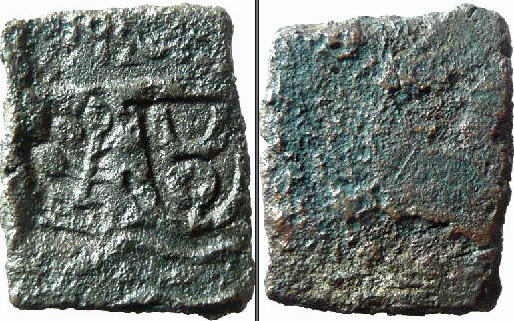
|
Eran-Vidisha AE 1/2 karshapana, Hastideva, four punch type
Weight: 4.89 gm., Dimensions: 18x14 mm.
Railed tree on left and taurine fixed in open railing on right; river at the bottom;
upside down legend punch at the top reading hathidevasa
Blank reverse
Reference: K.B. Tiwari 1981: 41 / Pieper 490 (plate coin)
|
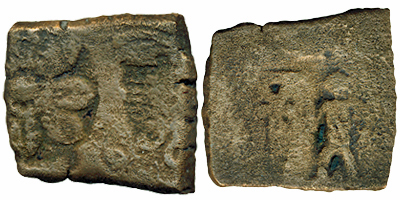
|
Eran-Vidisha AE 3/8 karshapana, Ravibhuti, four punch type
Weight: 3.54 gm., Dimensions: not stated by the auctioneers
Lotus flower, river symbol, tree, legend rajno ravibhutisa /
Large countermark depicting standing human figure beside Indradhvaja
Reference: S. Tiwari collection, p. 192 (that coin without reverse punch)
|
 |
The photo of the illustrated specimen is taken from Bhargava auction 9, coin 33. Such countermarks
depicting a standing human with or without Indradhvaja are known overstruck on several worn coin types from the Ujjain region and fom the Eran-Vidisha
region as well. The obverse design of this coin is too worn to be sure about the details; there possibly are traces of an 'Ujjain symbol'. Reportedly from Nandner.
|
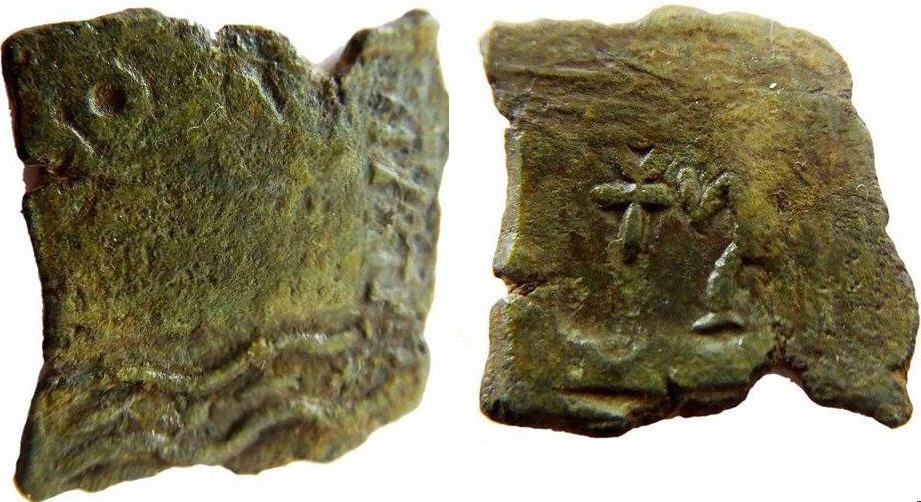
|
Eran-Vidisha region, AE 1/4 karshapana, Bhanumitra, 4 punch type
Weight: 2.19 gm., Diameter: 18 mm.
Legend punch at right reading rajno bhanumitasa; river symbol below,
above the river an 'Ujjain symbol' on left and railed tree on right /
Large countermark depicting standing human figure beside Indradhvaja
Reference: S. Tiwari collection, p. 180 var 1
|
 |
The large human countermark on reverse was also applied to other types from the region. See for example the previous coin.
The Shankar Tiwari Collection also includes Bhanumitra varieties with an 'Ujjain symbol' on reverse (possibly worn Ujjain undertypes have been used in those cases).
(Photo courtesy Prakash Jinjuvadiya.)
|

|
Eran-Vidisha AE 3/4 karshapana, Vajimitra, five punch type
Weight: 6.61 gm., Dimensions: not stated by the auctioneers
River at the bottom; elephant on the right; Brahmi legend vasumitasa on the left;
elaborate 'Ujjain symbol' on top left and railed tree on top right.
(turn the coin photo 90° to the right to have the river at the bottom, which is the
usual placement for all coins of the series)
Blank reverse
Reference: S. Tiwari collection, p. 178
|
 |
The photo of the illustrated specimen is taken from Bhargava auction 9, coin 25, reportedly from Nandner, and
identified as "Vasumitra." Shailendra Bhandare expressed his doubts as to the reliability of this reading. Having access to better preserved specimens he regards such a
reading, as it was proposed by previous researchers, as incorrect. Instead he sees all coins of this special punchmarked type as issues of Vajimitra.
|

|
Eran-Vidisha AE 3/4 karshapana, Vajimitra, five punch type
Weight: 6.42 gm., Dimensions: 21x20 mm.
River at the bottom; elephant on the right; Brahmi legend vajimitasa on the left;
'Ujjain symbol' at the top; tree symbol (not visible on this specimen)
Blank reverse
Reference: S. Tiwari collection, p. 180 / Pankaj Tandon collection
|
 |
The punchmarked types of "Vasumitra" and Vajimitra are very close to each other using the same set of
symbols and the same placement of the legend punch on the left, lending credence to Bhandare's assertion that they are all coins of Vajimitra.
|

|
Eran-Vidisha AE 1/2 karshapana, Damabhadra, four punch type
Weight: 3.85 gm., Dimensions: 17x16 mm.
Double orbed 'Ujjain symbol' on left and railed tree on right; river at the bottom;
legend punch on top reading damabhadasa
Damaru symbol flanked by two svastikas
Reference: Pieper 491 (plate coin)
|
 |
Satavahana Kings
|

|
Eran-Vidisha, AE 3/8 karshapana, Satakarni, five punch type
Weight: 3.64 gm., Dimensions: 20x17 mm.
From left to right elephant, 'Ujjain symbol' with crescent and railed Indradhvaja;
river at the bottom; legend punch on top reading siri satakanisa
Blank reverse
Reference: S. Tiwari collection, p.199/ Pieper 493 (plate coin)
|
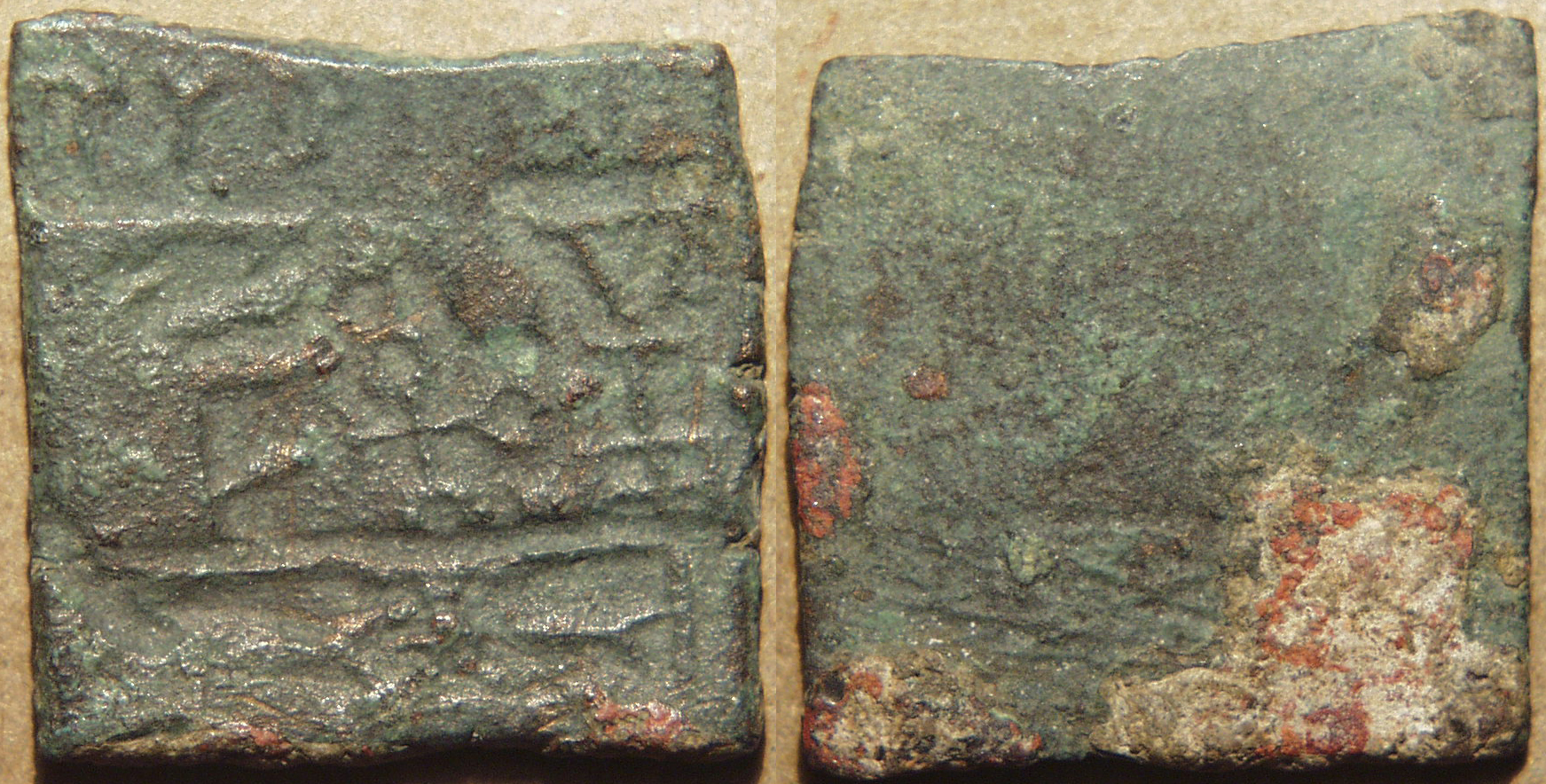
|
Eran-Vidisha, AE 3/8 karshapana, Satakarni, five punch type
Weight: 3.51 gm., Dimensions: 20x20 mm.
From left to right elephant, 'Ujjain symbol' with crescent and railed Indradhvaja;
river at the bottom; legend punch on top, weak letters, but probably reading
siri satakanisa.
Blank reverse
Reference: S. Tiwari collection, p.199/ Pankaj Tandon collection
|
 |
Bhagila
|
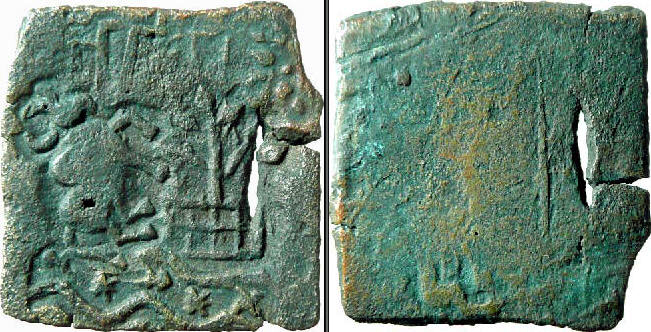
|
Bhagila, AE 3/8 karshapana, four punch 'bull type''
Weight: 3.11 gm., Dimensions: 19x19 mm.
Bull on the left, railed tree on right; river at the bottom; legend punch at the top
reading bhagilaya which is followed by a lotus flower.
Blank reverse
Reference: S. Tiwari collection, p.161, type 1,var.2 / Pieper 495 (plate coin)
|
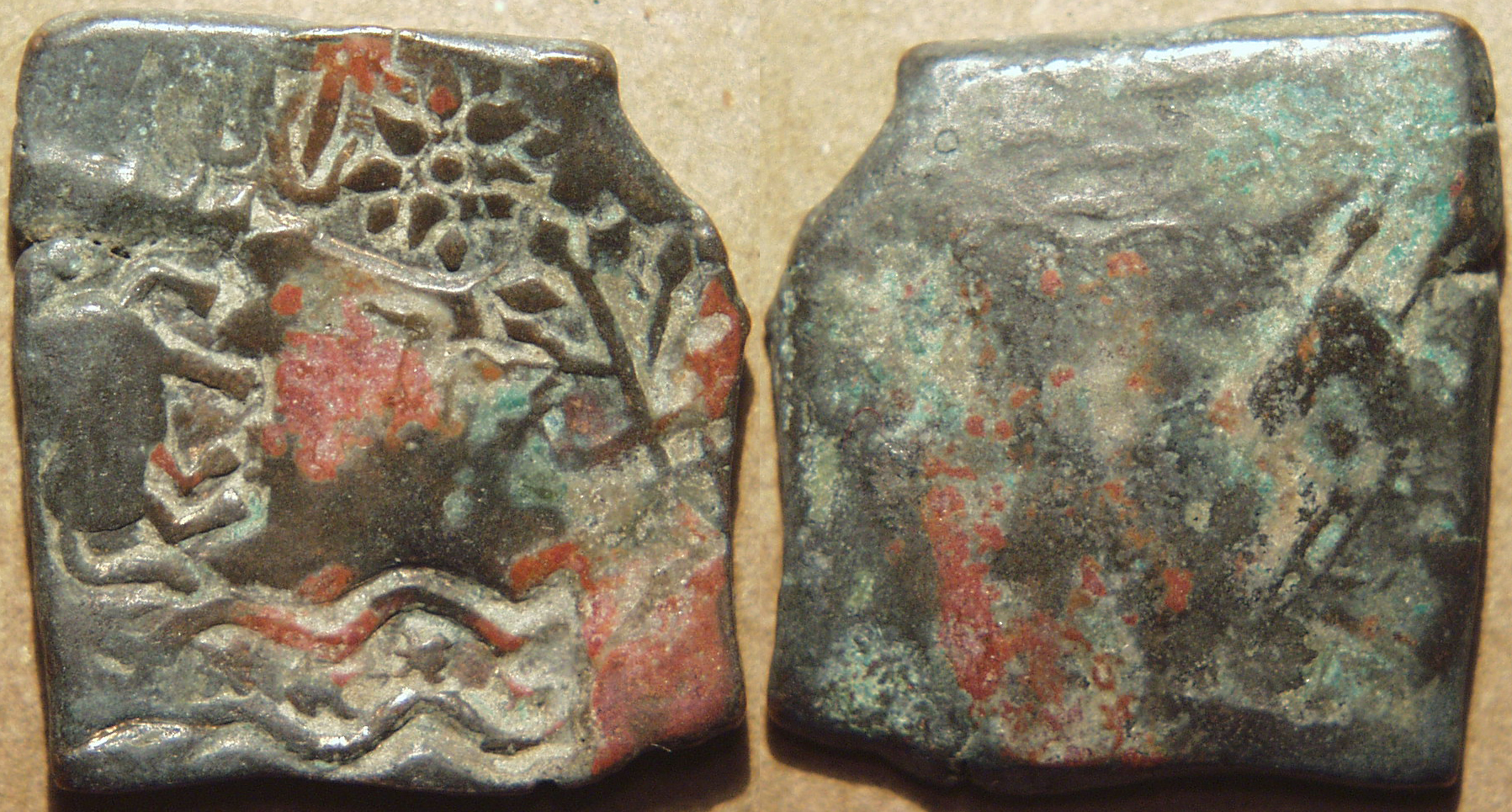
|
Bhagila, AE 3/4 karshapana, four punch 'bull type'
Weight: 6.88 gm., Dimensions: 22x21 mm.
Bull on the left, railed tree on right; river at the bottom; legend punch at the top
reading bhagilaya which is followed by a lotus flower.
Blank reverse
Reference: S. Tiwari collection, p.161, type 1,var.2 / Pankaj Tandon collection
|
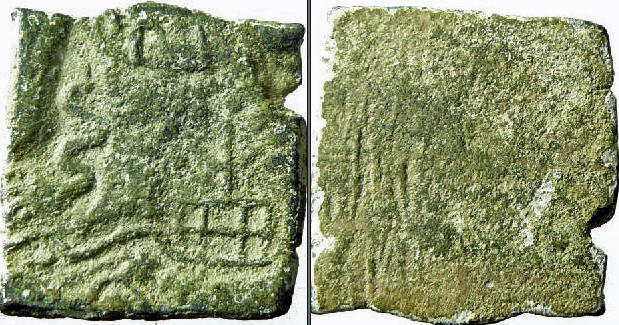
|
Bhagila, 1/2 AE karshapana, four punch 'cobra type'
Weight: 4.67 gm., Dimensions: 20x19 mm.
Cobra snake on the left and railed tree on the right; river at the bottom; on the top
is a legend punch reading upside-down bhagilaya followed by a lotus flower.
Blank reverse
Reference: S. Tiwari collection, p.163, type II, var.2 / Pieper 496 (plate coin)
|

|
Bhagila, AE 1/2 karshapana, four punch 'cobra type'
Weight: 5.03 gm., Dimensions: 21x21 mm.
Cobra snake on the left and railed tree on the right; river at the bottom; on the top
is a legend punch reading upside-down bhagilaya followed by a lotus flower.
Blank reverse
Reference: S. Tiwari collection, p.163, type II, var.2 / Pankaj Tandon collection
|
 |
Kurara
|

|
Kurara, die-struck AE
Weight: 1.01 gm., Dimensions: 11x9 mm.
Indradhvaja on left, taurine in open semicircle on right; Brahmi legend
kuraraya on top
Blank reverse
Reference: S. Tiwari collection, p.174, type VI / Pieper 498 (plate coin)
|

|
Kurara, die-struck AE
Weight: 1.51 gm., Dimensions: 12x11 mm.
Obv.: Railed tree on left; Indradhvaja on right; Brahmi legend kuraraya on top.
Rev.: Taurine fixed in open semi-circle
Reference: S. Tiwari collection, p.174, type V / Pieper 499 (plate coin)
|

|
Kurara, die-struck AE
Weight: 1.90 gm., Dimensions: 13x13 mm.
'Ujjain symbol' with nandipdada on one of its orbs on left;, railed tree on right;
Brahmi legend on top reading kuraraya
Blank reverse
Reference: S. Tiwari collection, p.172, class II / Pieper 500 (plate coin)
|

|
Kurara, die-struck AE
Weight: 0.98 gm., Dimensions: 11x10 mm.
Railed tree on left and Indradhvaja on right; Brahmi legend on top reading kuraraya
Srivatsa-on-railing on reverse.
Reference: / Pieper 501 (plate coin)
|
 |
Vidisha
|
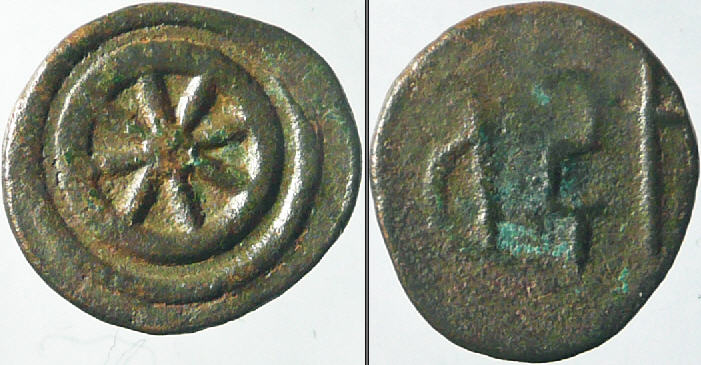
|
Vidisha, die-struck AE, wheel type
Weight: 1.18 gm., Dimensions: 13 mm.
Obv.: Eight-spoked wheel
Rev.: Brahmi legend reading vedisa
Reference: Pieper collection
|
 |
This civic type first came to light in 1961 and has since been reported in small numbers from time to time. In
'Numismatic Gleanings', 2012, by Devendra Handa and Major M.K.Gupta, pl.VI, coins 1-3 and p.48, Handa links the wheel symbol on this coin to the prevalence of
the Bhagavata cult at Vidisha. This cult found expression in several ways, among them in the erection of a Garuda-dhvaja in front of a temple of Vasudeva at the
ancient site of Vidisha: "...It is therefore not unlikely that this wheel may have represented the emblem of Vasudeva Vishnu." The occurrence of this chakra-like wheel
symbol on other coin types of Vidisha as well adds to the reliability of Handa's suggestion.
|

|
Vidisha, die-struck AE, horse # chakra type
Weight: ?, Dimensions: ? (weight and diameter not stated by the auctioneers)
Obv.: Horse to the left, part of legend vedisa below
Rev.: Chakra
Reference: The photo of this coin is taken from Bhargava auction 8, coin 31
|
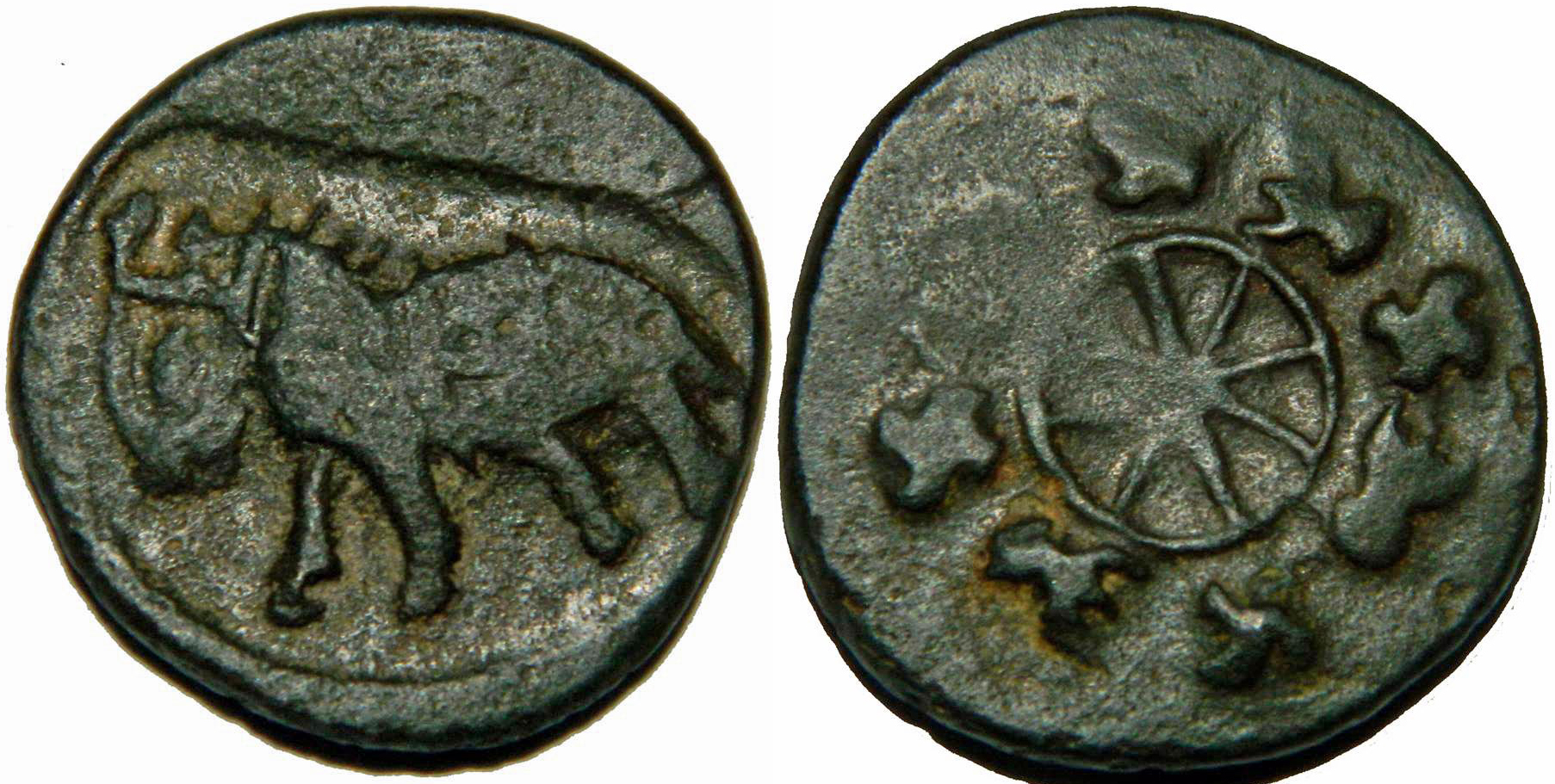
|
Vidisha, die-struck AE, 'horse/ chakra' type
Weight: 5.71 gm., Diameter: mm
Obv.: Bridled horse standing to left.
Rev.: Chakra symbol with a decorative outer border of alternating
svastikas and srivatsa symbols.
Reference: Girish Sharma collection
|
 |
Although this coin
is uninscribed the typology clearly allows a Vidisha attribution, the
more as the owner, Mr.Girish Sharma, confirms a Vidisha provenance. The
Vidisha attribution is certain when comparing this coin with the
'horse/ chakra' type listed above which has absolutely the same
unusually bridled horse on its obverse and a chakra on its reverse but
which is inscribed in the city name.
|

|
Vidisha, die-struck AE, hill type
Weight: ?., Dimensions: ? (weight and dimensions not stated by the auctioneers)
Three-arched hill with crescent on top; Brahmi legend below reading vedisa(sa)
Blank reverse
Reference: The photo of this coin is taken from Bhargava auction 8, coin 32
|
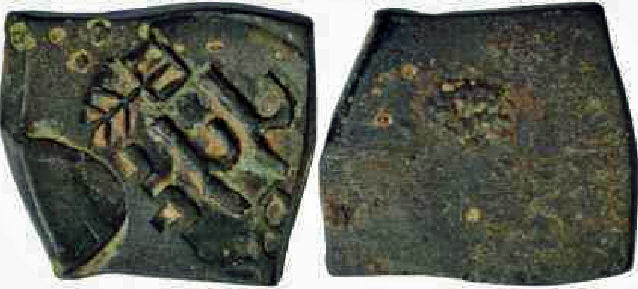
|
Vidisha, die-struck AE, uniface 'legend, tree and hill' type
Weight: 9.36 gm, Dimensions: ? (dimensions not stated by the auctioneers)
Obv: Centrally placed Brahmi legend (ve)disasa; railed tree at top; three-arched hill at the bottom.
Rev: Blank
Reference: Dilip Rajgor & Shankar Tiwari, ONS-NL 125 (1990), p.6, type 1
Photo from Classical Numismatic Gallery, auction 18, lot 7
|
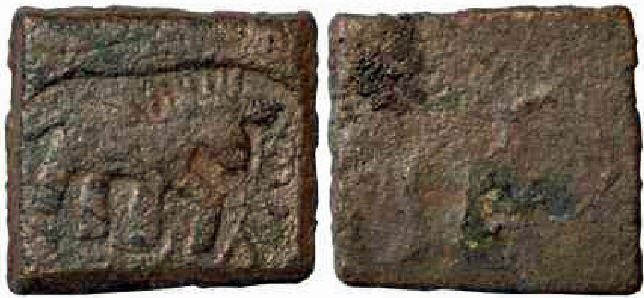
|
Vidisha, die-struck AE, uniface 'horse to right' type
Weight: 5.59 gm, Dimensions: ? (dimensions not stated by the auctioneers)
Obv: Horse walking to right; possibly parts of legend at bottom, overlapping circular symbols at right
Rev: Blank
Reference: Unpublished
Photo from Classical Numismatic Gallery, auction 18, lot 8
|

|
Possibly Vidisha, die-struck AE, deeply incused chakra type
Weight: 5.59 gm, Dimensions: ? (dimensions not stated by the auctioneers)
Obv: Chakra in deep round incuse
Rev: Blank
Reference: Unpublished
Photo from Bhargava auction 11, lot 51, described as northern Indian type without certain attribution.
|
 |
Nandinagar
|

|
Nandinagar, die-struck AE, 'hill & legend' type
Weight: 8.22 gm, Dimensions: ? (dimensions not stated by the auctioneers)
Obv: Three-arched hill with Brahmi legend 'nadinagara' above
Rev: Blank
Reference: Shankar Tiwari, Prachya Pratibha, vol.XII,1-2 (1984), p.77
Photo from Classical Numismatic Gallery, auction 18, lot 6
|
 |
Nandinagar is the ancient site of Nadner in
Hoshangabad district, MP. This is apparently the only Nandinagar city type known so far.
|
 |
 |
 |
Clay sealing
|

|
Malwa, clay sealing
Weight: 4.48 gm., Dimensions: 20x15 mm.
Railed yupa (sacrificial post) with side decorations and a Brahmi legend below reading khadasa
Reference: Pieper collection
|
 |
Thanks to Shailendra Bhandare for the correct reading. According to Bhandare the legend refers to the worship of
Skanda; similar objects pertaining to the Skanda cult have been reported from regions of Malwa, Vidarbha and the Deccan.
|
|
|